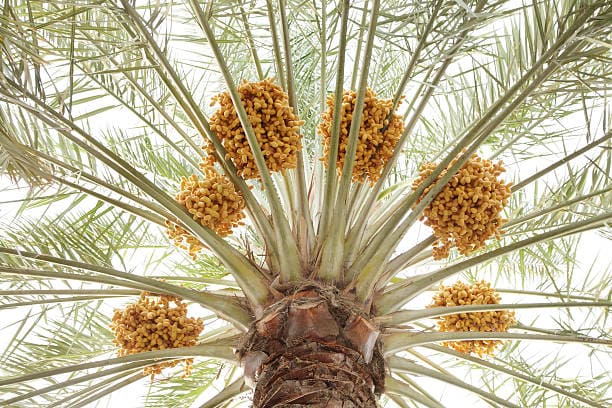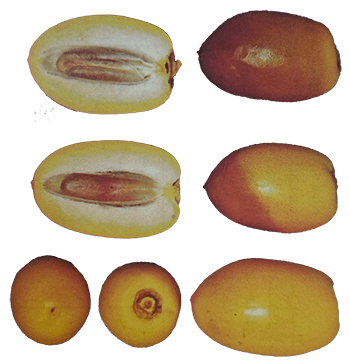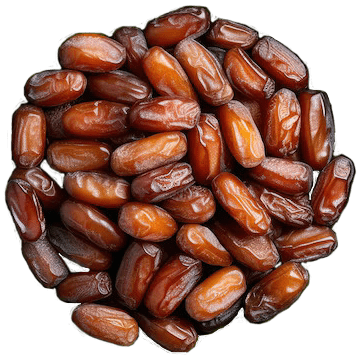Khalas Date palm : Characteristics, Cultivation Conditions, and Economic Importance
Khalas date palm is one of the most popular and finest date varieties in the world, sweet and soft, thus being in demand in all local and international markets. The Gulf countries such as Saudi Arabia and UAE are major producers of Khalas. The main characteristics of Khalas dates include the following:
- Shape: Medium-sized oval-shaped fruits with golden-yellow to light-brown color.
- (Texture: Soft and fleshy, with moderate moisture.
- Flavor: Sweet with a pleasant and distinctive aroma.
- Uses: Mainly consumed as fresh dates – Rutab – and occasionally used in the production of date syrup and other processed products.
Ideal Conditions Required by Khalas Date palm to Grow
- Suitable Soil:
- Khalas thrives on sandy-loam soils that are well drained.
- The soil should be rich in organic matter with a pH of 7 to 8.5.
- Soil Salinity: Its relative tolerance to soil salinity allows it to be grown on semi-saline soils.
- Water Requirements:
- This variety has moderate water requirements, and drip irrigation systems are advisable to prevent water loss.
- The quality of the water used should be good, with less than 3000 microsiemens per centimeter salinity.
- Climatic Conditions:
- It requires a hot and dry climate.
- Optimal temperature range for growth: 25 to 45°C.
- Fruit quality improvement requires direct sunlight.
- This variety is tolerant of heat and drought stresses.
- Planting Density and Orchard Layout:
- Planting distance: 8 – 10 meters between trees.
- Proper spacing allows ample sunlight and aeration that is conducive to healthy growth and minimizes pest problems.

Cultivation and Harvesting
Cultivation Practices:
- Propagation: Khalas date palms are conventionally propagated using offshoots or tissue culture saplings for maintaining genetic purity and ensuring uniformity in fruit quality.
- Fertilization: Organic manure and balanced fertilizers, heavy in potassium and phosphorus, need to be applied regularly to ensure good growth.
- Irrigation Management: Very frequent irrigation is required at the initial growth stage of the palm, with subsequent reduction in frequency as it matures. Drip irrigation is highly recommended.
- Pest and Disease Control: This variety is very prone to attacks by red palm weevil insects and fungal diseases like black scorch; integrated pest management strategies need to be followed.
HARVESTING
- Stages of Maturity: o Khalal Stage: Mid-summer (July), where the fruit is firm and partially ripe. o Rutab Stage: Late August, during which the fruit softens and develops its characteristic sweetness. o Tamr Stage: When the date fully ripens with less moisture inside; this is suitable for long-term storage.
- Techniques: Dates are picked manually or mechanically using lifters, ensuring minimum fruit damage.
- Post-Harvest Handling: Proper sorting, washing, and packaging will ensure the quality and prolong the shelf life.
Pollinators for Khalas Date palm
Selection of proper varieties for pollination is very critical to ensure highest yield, and the most recommended include:
- The Phoenix species; males are preferred among the varieties that are extremely good for pollen, especially Medjool and Deglet Noor
- Mechanical or Manual pollinations are also usually conducted to aid in efficiency
Major cultivation areas for Khalas Date palm worldwide
There has been extended cultivation of khalas across the world, mainly dictated by the ever-increasing demand. These places include;
- Saudi Arabia: The largest producer of Khalas dates in the world, with more than 150,000 hectares under cultivation. Major growing areas include Qatif and Al-Ahsa.
- United Arab Emirates: Produces high-quality Khalas dates because of its favorable climatic conditions.
- Iraq: One of the oldest date producers in the world, with extensive cultivation of a wide variety of dates, including Khalas.
- North African Countries: Countries like Egypt and Tunisia also cultivate Khalas dates, but their volume of production is relatively less than that of the Gulf countries.
Khalas Date Harvesting Time
Harvesting time for Khalas dates depends on weather conditions and orchard practices. However, it is usually:
- Khalal Stage: Mid-summer (July).
- Rutab and Tamr Stages: Late August to September.
- Fruit is to be harvested carefully without damage to maintain quality.
Global Cultivation of Khalas Date palm
The cultivation of Khalas dates is increasing globally due to its high demand in the market. Key statistics include:
- Saudi Arabia: More than 150,000 hectares and thus considered the leading producer.
- United Arab Emirates: Extensive cultivation provides dates of the highest quality.
- Iraq: Large areas dedicated to Khalas and other varieties
- North Africa: Countries like Egypt and Tunisia contribute to the supply of Khalas dates worldwide.
Conclusion
With all its characteristics, Khalas dates stand as a strategic and economic commodity for farmers in arid and semi-arid regions of the world. There is a great potential to improve the production and profitability of this exceptional date variety through proper water and soil management practices, scientific methods of pollination, and building up export infrastructure.



I like this blog very much, Its a really nice position to read and find info . “The mark of a good action is that it appears inevitable in retrospect.” by Robert Louis Stephenson.